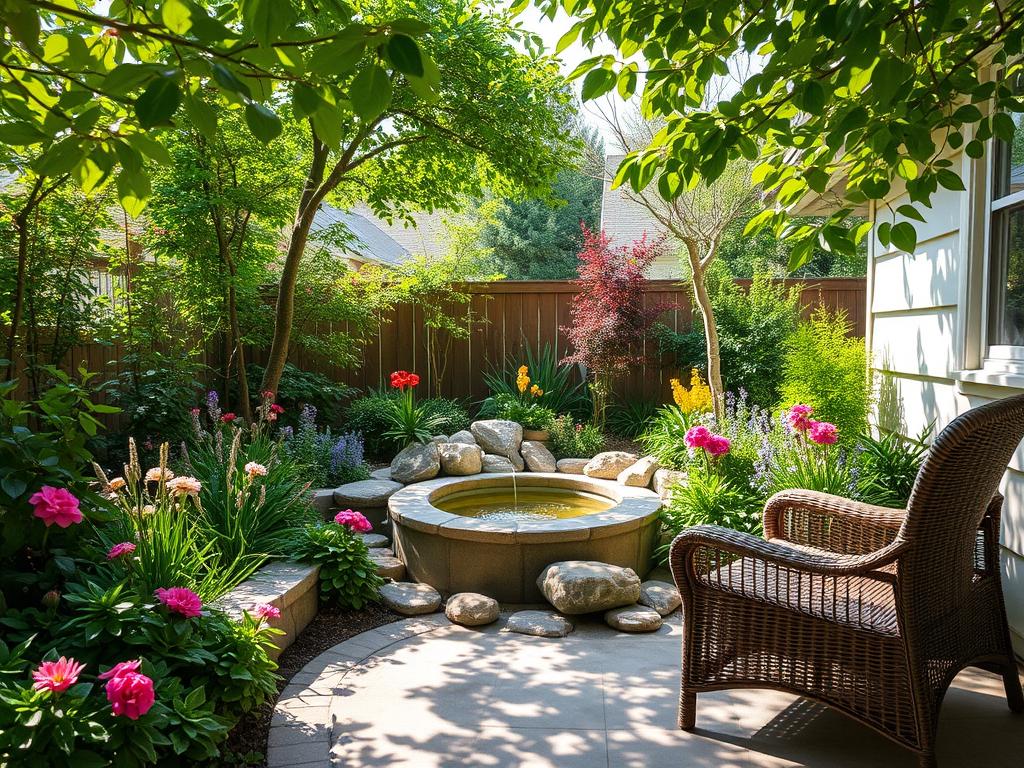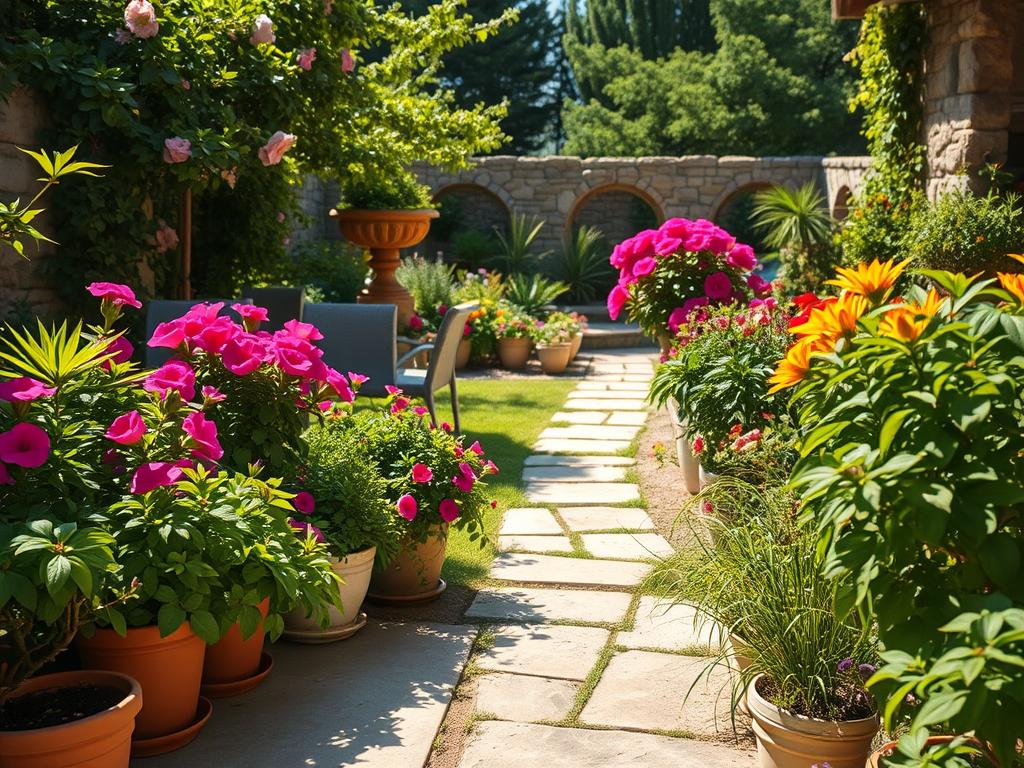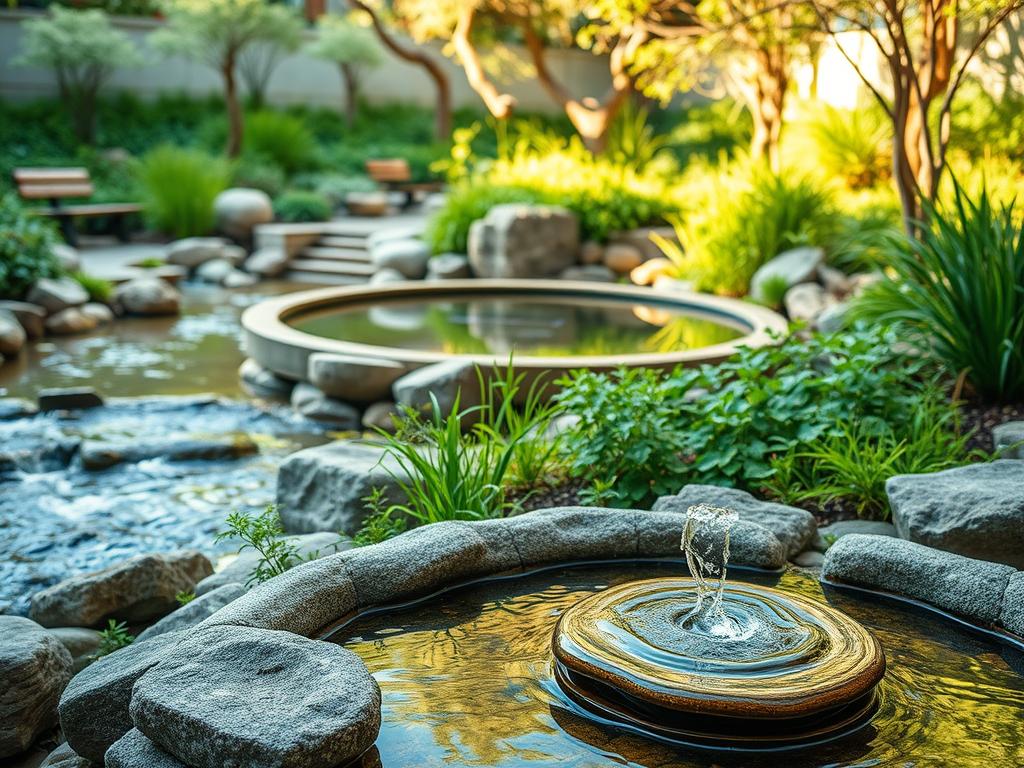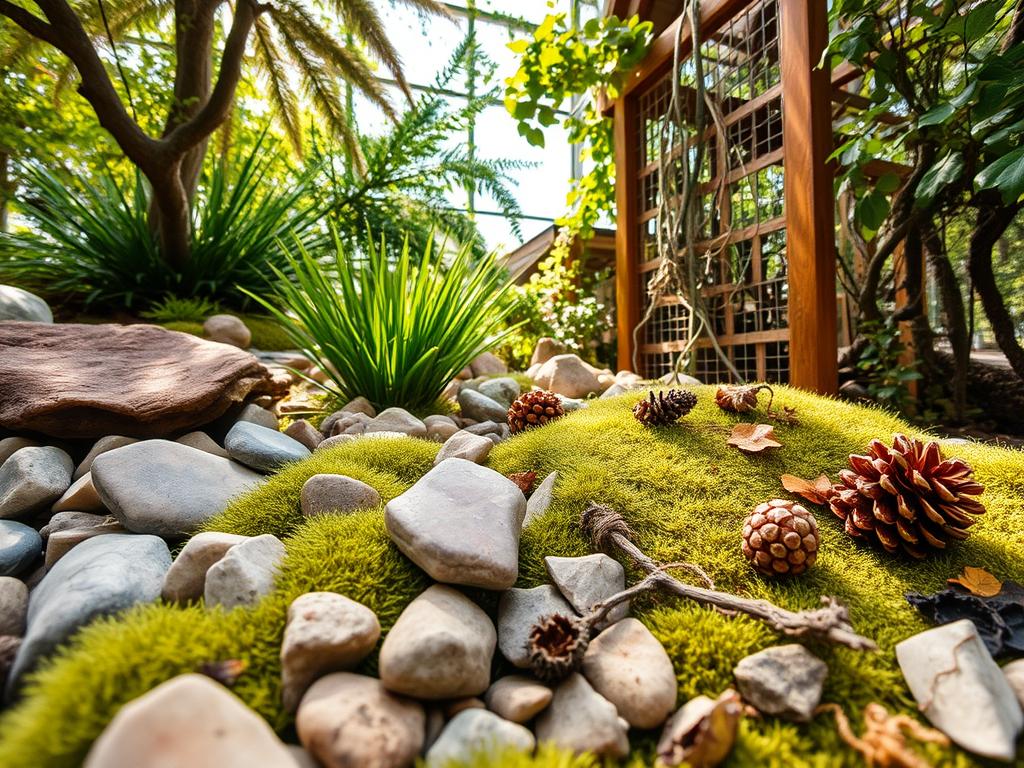
Creating a Sensory Garden on Your Patio: Engage All Your Senses
Imagine stepping into your outdoor space and being transported to a world where every sense is delighted. Can a simple patio transformation truly engage all your senses and enhance your outdoor experience?
A well-designed garden design can turn your patio into a haven that not only pleases the eye but also soothes the mind and delights the senses. By incorporating a variety of textures, colors, and fragrances, you can create a multisensory experience.
By thoughtfully designing your patio, you can craft a space that invites relaxation and enjoyment. This can be achieved by carefully selecting plants, features, and elements that stimulate the senses, creating a truly immersive experience.
What is a Sensory Garden and Its Benefits?
Sensory gardens are therapeutic outdoor areas that engage the senses, fostering a deeper connection with nature. These gardens are designed to stimulate the senses, including sight, sound, touch, taste, and smell, creating a holistic experience.
Definition of a Sensory Garden
A sensory garden is a specially designed outdoor space that incorporates various elements to stimulate the senses. It combines plants, water features, and other natural elements to create an immersive experience. The goal is to engage visitors on multiple sensory levels, promoting relaxation and well-being.
The design of a sensory garden can vary widely, depending on the available space and the desired experience. It may include fragrant plants, colorful flowers, textured foliage, and edible plants, among other features.
Benefits for All Age Groups
Sensory gardens offer benefits for people of all ages. For children, they provide an interactive and educational environment, encouraging exploration and learning. For adults, they offer a peaceful retreat from the stresses of daily life. For the elderly, they can be a nostalgic reminder of past experiences and a source of comfort.
The benefits of sensory gardens are not limited to individuals; they can also enhance community spaces, providing a shared area for relaxation and socialization.
| Age Group | Benefits |
|---|---|
| Children | Interactive learning, sensory exploration |
| Adults | Stress relief, relaxation, connection with nature |
| Elderly | Nostalgia, comfort, sensory stimulation |
Importance of Multisensory Experiences
Multisensory experiences are crucial in sensory gardens as they engage visitors on multiple levels. By incorporating a variety of sensory stimuli, these gardens create a richer and more immersive experience. This can lead to a deeper connection with nature and improved well-being.
Nature therapy, which is often associated with sensory gardens, has been shown to have numerous health benefits, including reduced stress levels and improved mental health.
Choosing the Right Location for Your Patio Garden
Selecting the ideal location for your sensory garden is crucial for its overall appeal and functionality. A well-chosen location can enhance the multisensory experience, making your outdoor space a haven for relaxation and enjoyment.

Evaluating Space Constraints
Before designing your sensory garden, it’s essential to assess the available space on your patio. Consider the size and shape of the area, as well as any existing features that could impact your garden’s layout. Measure the space carefully to determine the best configuration for your garden’s elements.
Think about the paths you want to create, the placement of plants, and any other features you wish to include, such as seating areas or water features. A well-planned layout will ensure that your garden feels spacious and inviting, even in smaller patios.
Sunlight and Shade Considerations
The amount of sunlight your patio receives is a critical factor in choosing the right location for your sensory garden. Most plants require a certain amount of sunlight to thrive, so it’s crucial to assess the sunlight patterns throughout the day.
Consider the orientation of your patio and the presence of any shade-providing elements, such as trees or umbrellas. Balancing sunlight and shade will not only support plant health but also create a more dynamic and interesting sensory experience.
Accessibility Features
Ensuring that your sensory garden is accessible is vital for enjoying its benefits. Consider incorporating wide pathways and comfortable seating areas that are easily reachable.
For individuals with mobility issues, it’s also important to include features like gentle slopes or ramps, and to avoid obstacles that could hinder movement. By making your garden accessible, you can create an inclusive outdoor space that everyone can enjoy.
Selecting Plants to Stimulate the Senses
Plant selection plays a pivotal role in creating a sensory garden that delights and engages visitors. The right plants can stimulate the senses, creating a multisensory experience that is both therapeutic and enjoyable.
To effectively stimulate the senses, it’s essential to choose plants that cater to different sensory experiences. This includes plants with distinct fragrances, vibrant colors, varied textures, and edible parts.
Fragrant Plants for Smell
Fragrant plants are a crucial element in a sensory garden, as they can evoke emotions and create a lasting impression. Some popular fragrant plants include lavender, known for its calming effects, and rosemary, which adds a herbaceous note to the garden. Incorporating a variety of fragrant plants like jasmine and gardenias can further enhance the sensory experience.

Colorful Flowers for Sight
Colorful flowers are another vital component, as they add visual appeal and create a dynamic landscape. Flowers like tulips, sunflowers, and daisies come in a variety of colors and can be arranged to create a visually stimulating display. By incorporating a mix of annuals and perennials, you can ensure that your garden remains vibrant throughout the growing season.
Textured Foliage for Touch
Incorporating plants with varied textures can add depth to your sensory garden. Plants like lamb’s ear with its soft, velvety leaves, and succulents with their thick, fleshy leaves, provide a tactile experience. Visitors can engage with these plants by touching, thereby enhancing their sensory experience.
Edible Plants for Taste
Edible plants not only add flavor to your sensory garden but also provide an interactive element. Incorporating herbs like basil, mint, and lemongrass, as well as fruits and vegetables, can create a garden that is both beautiful and functional. Be sure to label edible plants clearly to encourage visitors to explore and taste.
Integrating Water Features for Sound and Calm
Water features are a crucial element in creating a multi-sensory environment that stimulates relaxation and serenity in your sensory garden.
The incorporation of water elements can significantly enhance the overall ambiance, making your outdoor space more inviting and peaceful.
Types of Water Features
There are various types of water features you can integrate into your sensory garden, each offering unique benefits and aesthetic appeal.
- Ponds with fountain installations
- Small waterfalls or cascades
- Birdbaths or simple bubblers
- Reflecting pools for a mirror-like effect
Choosing the right water feature depends on the available space, desired sound level, and maintenance preferences.

Maintenance Tips
To ensure your water feature remains a serene and enjoyable part of your sensory garden, regular maintenance is essential.
This includes checking water levels, cleaning the feature to prevent algae buildup, and ensuring that pumps and filters are functioning correctly.
Regular maintenance not only prolongs the life of your water feature but also keeps it looking its best.
Benefits of Water Sounds
The sound of water is inherently calming and can significantly contribute to the relaxing atmosphere of your sensory garden.
Water sounds can mask unwanted background noises, creating a more peaceful environment that encourages relaxation and mindfulness.
The gentle gurgling or soft splashing of water can be particularly therapeutic, promoting a sense of calm and well-being.
Adding Textures and Materials to Engage Touch
Incorporating a variety of textures and materials is crucial for creating a sensory garden that engages the sense of touch. A well-designed sensory garden should stimulate the senses, including touch, to provide a holistic experience. This is particularly important in horticultural therapy, where the tactile experience can be therapeutic.
The selection of materials and textures can significantly impact the sensory experience. For instance, the choice of pathway surfaces can greatly influence the tactile experience of visitors.
Choosing Surfaces for Pathways
The surface of pathways in a sensory garden can vary from smooth stone to rough gravel or soft, grassy terrain. Each surface provides a unique tactile experience. For example, smooth stone or concrete can be comfortable for walking, while gravel or sand can provide a more dynamic sensory experience underfoot.
| Surface Type | Tactile Experience | Maintenance Level |
|---|---|---|
| Smooth Stone | Comfortable, smooth | Low |
| Gravel | Rough, shifting | Medium |
| Grass | Soft, natural | High |
Incorporating Natural Elements
Incorporating natural elements such as wood, stone, and plants can add variety to the tactile experience. Using natural materials for garden features like benches, planters, and decorative elements can enhance the sensory experience.

Using Different Plant Textures
Plants with different textures can significantly contribute to the tactile experience in a sensory garden. Plants with soft leaves, prickly stems, or smooth bark can provide a range of sensations. Visitors can be encouraged to touch and explore these different textures, enhancing their sensory experiences.
Some examples of plants with interesting textures include lamb’s ear for its soft, fuzzy leaves, and cacti for their prickly stems. Incorporating a variety of plant textures can add depth and complexity to the sensory garden.
By carefully selecting and incorporating various textures and materials, a sensory garden can provide a rich and engaging experience, particularly in the context of horticultural therapy.
Creating Inviting Spaces for Relaxation
Transforming your patio into a sensory garden requires careful planning to create inviting spaces for relaxation. A well-designed outdoor space can become a serene oasis, perfect for unwinding after a long day.
One of the key elements in creating a relaxing atmosphere is comfortable seating. When designing your sensory garden, consider incorporating a variety of seating options to cater to different preferences.
Seating Options for Comfort
Comfortable seating is essential for creating inviting spaces within your sensory garden. You can choose from a range of options, including:
- Plush outdoor sofas and armchairs
- Reclining garden loungers
- Built-in benches with storage
- Hang hammocks or swings for a more relaxed vibe
When selecting seating, consider the materials and textures used, ensuring they are durable and weather-resistant.
Shade Solutions for Coolness
Adequate shade is crucial for making your sensory garden a cool and inviting space. There are several shade solutions you can incorporate into your garden design:
- Install a pergola or gazebo
- Use umbrellas or canopies
- Plant trees or shrubs that provide natural shade
These shade solutions not only provide relief from the sun but also add to the aesthetic appeal of your garden.
Decorative Elements to Enhance Ambiance
The ambiance of your sensory garden can be significantly enhanced with the right decorative elements. Consider adding:
- Soft lighting, such as string lights or lanterns
- Water features, like small fountains or birdbaths
- Artistic sculptures or garden ornaments
These elements can create a calming and engaging atmosphere, making your sensory garden a perfect spot for relaxation.
By incorporating comfortable seating, effective shade solutions, and thoughtful decorative elements, you can create inviting spaces within your sensory garden that promote relaxation and serenity.
Including Artistic Elements for Visual Stimulation
To elevate the sensory experience of your garden, consider integrating various artistic elements that stimulate visual stimulation. Artistic elements can transform a sensory garden into a vibrant and engaging space that fosters nature therapy and relaxation.
The incorporation of artistic elements is not just about aesthetics; it’s about creating an immersive experience that complements the natural beauty of the garden. By thoughtfully selecting and placing art pieces, you can enhance the overall ambiance and create a unique therapeutic garden environment.
Sculptures and Statues
Sculptures and statues can add a touch of elegance and personality to your sensory garden. They can be used to create focal points, add texture, and introduce interesting shapes and forms.
- Choose sculptures that resonate with the natural surroundings.
- Consider the material and durability of the sculpture.
- Place sculptures strategically to guide visitors through the garden.
Garden Art Ideas
Garden art is a broad category that encompasses a wide range of creative expressions, from mosaics to metalwork. Incorporating garden art can add visual interest and personality to your sensory garden.
Some ideas include:
- Mosaic pathways or wall art.
- Metal sculptures or wind chimes.
- Glass art or ornaments.
| Art Form | Description | Benefits |
|---|---|---|
| Mosaic Art | Colorful, intricate designs made from tile or glass. | Adds visual stimulation and beauty. |
| Metal Sculptures | Durable, weather-resistant art pieces. | Provides texture and interest. |
| Glass Art | Transparent or colored glass ornaments or sculptures. | Catches light, adds elegance. |
Color Theory in Garden Design
Color theory plays a significant role in garden design, influencing mood and perception. By carefully selecting a color palette, you can create a harmonious and visually appealing sensory garden.
Consider the following principles:
- Use a mix of complementary colors to create contrast.
- Analogous colors can create a soothing and cohesive look.
- Consider the color of sculptures, flowers, and foliage.
By incorporating artistic elements and applying color theory principles, you can create a sensory garden that is not only beautiful but also therapeutic and engaging. This holistic approach to garden design can enhance the overall experience, making your garden a true haven for relaxation and nature therapy.
Maintenance Tips for a Thriving Sensory Garden
Maintaining your sensory garden is key to its longevity and effectiveness. A well-cared-for garden continues to engage the senses and provide a serene escape. Proper maintenance ensures that the multi-sensory environment remains vibrant and inviting.
Seasonal Care Checklist
To keep your sensory garden thriving, it’s essential to follow a seasonal care checklist. This includes:
- Spring: Prune plants, clean up debris, and apply fertilizer to promote new growth.
- Summer: Water plants regularly, control weeds, and monitor for pests.
- Autumn: Clean up fallen leaves, divide and replant perennials as needed, and prepare plants for winter.
- Winter: Protect sensitive plants from frost, prune deciduous trees and shrubs, and plan for the upcoming growing season.
Pest Management Strategies
Effective pest management is crucial for maintaining the health and beauty of your sensory garden. Strategies include:
- Using natural pest control methods whenever possible, such as introducing beneficial insects.
- Regularly inspecting plants for signs of pests or disease.
- Maintaining good garden hygiene to prevent the spread of disease.
Watering and Fertilization Techniques
Proper watering and fertilization are vital for the health of your sensory garden. Techniques to consider include:
- Watering plants deeply but infrequently to encourage deep root growth.
- Using a balanced fertilizer during the growing season to promote healthy plant development.
- Adjusting fertilization based on plant selection and soil conditions.
By following these maintenance tips, you can ensure your sensory garden remains a thriving multi-sensory environment that delights and inspires.
Inspiring Sensory Garden Examples Across the Country
Sensory gardens can be found in various settings, from public spaces to private homes, and they offer a unique way to engage with nature. The diversity of these gardens is a testament to the versatility of horticultural therapy and the importance of sensory experiences.
Public Sensory Gardens Worth Visiting
Public sensory gardens, such as those found in botanical gardens and parks, provide accessible spaces for people to explore and relax. The New York Botanical Garden and the Chicago Botanic Garden are notable examples, featuring a range of plants and features that stimulate the senses.
Successful Home Sensory Garden Projects
Homeowners can also create their own sensory gardens, tailored to their specific needs and climates. Successful projects often incorporate a mix of fragrant plants, colorful flowers, and textured foliage, creating a multisensory experience.
Climate Considerations in Sensory Garden Design
Local climate plays a significant role in determining the design and plant selection for sensory gardens. Understanding the local climate and choosing plants accordingly is crucial for creating a thriving Sensory Garden.
Leave a Reply